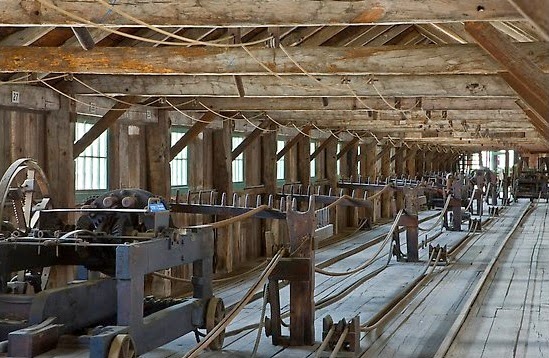The true origins of the
craft of rope making are lost in history, but there is fossil evidence of rope
usage dating back to 17000BC. These
early ropes were likely
to be long pieces of vine twisted or braided together by hand. The ancient
Egyptians were most likely the first civilization to develop tools for
constructing ropes around 4000BC. Such ropes would have been made out of
grass, water reeds or animal hair. These ropes would have been used by the
Egyptians in constructing their colossal structures such as the pyramids that
still stand today. Hemp fibres were first used to make ropes by the Chinese
around 2800BC and after this, rope making spread throughout the rest of Asia
and to Europe.
In Europe, twisted rope has been hand-made using the
ropewalk method since the Middle Ages and by the late 1700s advances in technology meant that several
machines for making rope had been constructed. Ropewalks were harsh working
environments and would often catch fire as they were made mainly of wood and
hemp dust can create an explosive mixture. Natural fibre yarns would be twisted
to form strands which would spread the length of the building. These would then
be counter-twisted to form the rope. The length of the walk
would limit the length of rope that could be made but this allowed for ropes to be as long
as 300 yards for use on sailing ships, for which they were essential. The
standard length for a British Naval Rope was 1000 feet and a sailing ship
such as HMS Victory would
require over 20 miles of rope.
 |
| A Typical Early Ropewalk |
Braided cords have also been around for centuries, but up until the 1800s they had all been braided by hand. When automatic braiding machines were invented in the Victorian era, rope factories became capable of producing high volumes of braided cords. Braiding machines were initially used for smaller cords and laces but the development of larger braiding machines meant that by the middle of the Twentieth Century the production of braided rope became widespread.
Prior to the
development of nylon by the laboratories of E. I. Dupont de Nemours in 1939,
the only materials that were available to cordage manufacturers were natural
fibres. The development of polyester and polypropylene followed in the 1940s
and 50s and this revolutionized the textile and cordage industries. These developments meant that alongside the
traditional natural fibres of manila, sisal, hemp, flax, cotton and jute, ropes
today are more commonly made from nylon, polypropylene, polyethylene and
polyester. This is because synthetic ropes are generally stronger, lighter and
more hardwearing than the natural alternatives. You can find a wide range of both natural and synthetic, twisted and braided ropes here.

These ropes would have been used by the building their colossal constructions such as the pyramids that still stand today. Hemp fibers were first used to make ropes by the Chinese around 6mm, 8mm to 38mm, 40mm and after this, expert sisal rope supplier and manufacturer in china.
ReplyDeleteyes these ropes are mainly used for the construction purpose. Nicely described great to visit here!
ReplyDeletePolyester Rope Suppliers
I'M NOW FULFILL FINANCIALLY BECAUSE OF THE LOAN I GOT FROM LFDS .I would like to bring this to the notice of the public about how i came in contact with LFDS after i lost my job and being denied loan by my bank and other financial institution due to my credit score. I could not pay my children's fees. I was behind on bills, about to be thrown out of the house due to my inability to pay my rent, It was during this period my kids were taken from me by foster care. Then i set out to seek for funds online where i lost $3,670 that i borrowed from friends which i was rip off by two online loan companies. Until i read about:Le_Meridian Funding Service (lfdsloans@outlook.com / lfdsloans@lemeridianfds.com) somewhere on the internet, Still wasn't convince because of what i have been through until a relative of mine who is a clergy also told me about the ongoing loan scheme of LFDS at a very low interest rate of 1.9%% and lovely repayment terms without penalty for default of payment. I have no choice than to also contact them which i did through text +1-989-394-3740 and Mr Benjamin responded back to me That day was the I'M best and greatest day of my life which can never be forgotten when i receive a credit alert of $400,000.00 Usd loan amount i applied for. I utilized the loan effectively to pay up my debts and to start up a business and today i and my kids are so happy and fulfill. You can as well contact them through email: (lfdsloans@outlook.com / lfdsloans@lemeridianfds.com) WhatsApptext helpline: +1-989-394-3740 Why am i doing this? I am doing this to save as many that are in need of a loan not to be victim of scams on the internet. Thanks and God bless you all, I'm Oleksander Artem from Horizon Park BC , Ukrain.
ReplyDelete